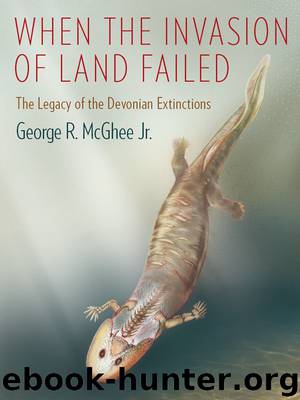When the Invasion of Land Failed by George R. McGhee Jr

Author:George R. McGhee, Jr.
Language: eng
Format: epub
Tags: -
Publisher: Columbia University Press
Published: 2013-10-12T04:00:00+00:00
The genera display considerable postcranial variation, but their jaw morphology and head shape are strikingly uniform; these common features must have characterized the actual stem lineage, and may be evidence for a conserved mode of prey capture. … This suggests that Ventastega, Acanthostega, and Ichthyostega are conservative survivors from a Lower Famennian (or earlier) radiation.3 (emphasis mine)
Ventastega (figs. 3.4 and 3.6) is indeed thought to belong to a ghost lineage that survived from the Frasnian, and Acanthostega and Ichthyostega are new Famennian genera of tetrapods that we will encounter in this chapter. In 2012, Clack further notes that both of the Frasnian species Sinostega pani and Metaxygnathus denticulus “seem to resemble Famennian forms” and agrees with Ahlberg in that “this could be taken to mean that the specialized Frasnian forms suffered during the Frasnian–Famennian extinction event, to be wiped out in favor of the more conservative forms”4 (emphasis mine).
After the end-Frasnian extinction, only a single species is known from the fossil record in the Famennian Gap: Jakubsonia livnensis, which was found in Russia, part of the territorial range of the extinct Frasnian species Obruchevichthys gracilis in southeast Laurussia (color plate 8). In fact, of the new tetrapod species seen in the second invasion of land, all appear only in Laurussia and only two species are known outside of the tropical region of Laurussia. The worldwide geographic range seen in Frasnian tetrapod species was gone (color plate 8), and the new tetrapod species appearing in the late Famennian was markedly restricted in their geographic range (color plate 11).
The reductions in morphological variance and geographic range seen in the tetrapod species appearing in the fossil record in and after the Famennian Gap are classic evolutionary bottleneck phenomena, and I refer to the cause of these effects as the “End-Frasnian Bottleneck.”5 The legacy of the End-Frasnian Bottleneck in shaping the subsequent evolutionary history of terrestrial vertebrates, our ancestors, will be explored in more detail in chapter 8.
Download
This site does not store any files on its server. We only index and link to content provided by other sites. Please contact the content providers to delete copyright contents if any and email us, we'll remove relevant links or contents immediately.
Man-made Catastrophes and Risk Information Concealment by Dmitry Chernov & Didier Sornette(5901)
The Revenge of Geography: What the Map Tells Us About Coming Conflicts and the Battle Against Fate by Kaplan Robert D(4026)
Zero Waste Home by Bea Johnson(3762)
COSMOS by Carl Sagan(3539)
Good by S. Walden(3468)
In a Sunburned Country by Bill Bryson(3466)
The Fate of Rome: Climate, Disease, and the End of an Empire (The Princeton History of the Ancient World) by Kyle Harper(2988)
A Wilder Time by William E. Glassley(2805)
Camino Island by John Grisham(2749)
The Ogre by Doug Scott(2620)
Organic Mushroom Farming and Mycoremediation by Tradd Cotter(2616)
Human Dynamics Research in Smart and Connected Communities by Shih-Lung Shaw & Daniel Sui(2459)
Energy Myths and Realities by Vaclav Smil(2422)
The Traveler's Gift by Andy Andrews(2396)
9781803241661-PYTHON FOR ARCGIS PRO by Unknown(2311)
Inside the Middle East by Avi Melamed(2294)
Birds of New Guinea by Pratt Thane K.; Beehler Bruce M.; Anderton John C(2214)
A History of Warfare by John Keegan(2172)
Ultimate Navigation Manual by Lyle Brotherton(2116)
